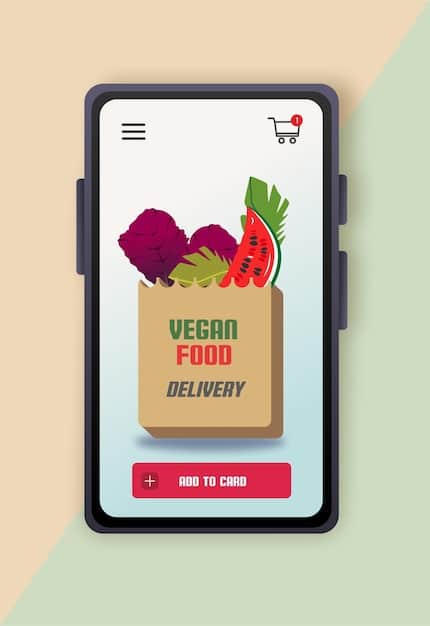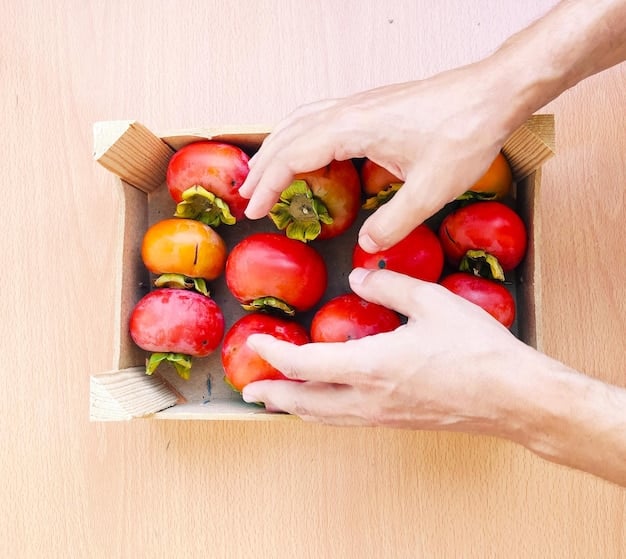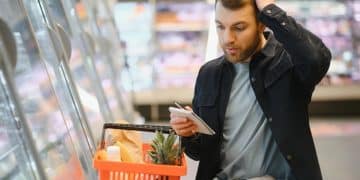Grocery Delivery vs. In-Store Shopping: Which Saves Money?

Navigating the financial implications of grocery delivery versus in-store shopping requires a detailed analysis of service fees, hidden costs, time value, and promotional offerings to determine which method ultimately saves consumers more money in 2025.
In the evolving landscape of consumer habits, the question of whether grocery delivery or traditional in-store shopping offers greater financial savings remains a central consideration for many households. Understanding the nuances of each option is crucial for making informed decisions—decisions that impact budgets and lifestyles alike.
The Lure of Convenience: Understanding Grocery Delivery Costs
Grocery delivery services have become a prevalent fixture in modern life, promising unparalleled convenience right to your doorstep. This ease, however, often comes with a price tag that extends beyond the listed item prices. Unpacking these costs is the first step in determining the true financial impact.
Service Fees and Markups
Many grocery delivery platforms levy a service fee on each order, which can vary significantly depending on the provider and the order total. This fee is often a percentage of your total bill, adding a palpable increase to your overall spend. Beyond explicit service fees, some platforms may also implement price markups on individual items, meaning a loaf of bread or a gallon of milk might cost more through the delivery app than it would in the physical store. This can be a subtle but significant factor influencing your final bill.
- Variable pricing: Check if the delivery service marks up individual item prices compared to in-store prices.
- Order minimums: Be aware of minimum order requirements that might compel you to buy more than intended.
- Membership models: Evaluate if a subscription service (e.g., Amazon Prime, Instacart+) offsets per-order fees for frequent users.
Delivery Fees and Tips
Perhaps the most obvious added cost of grocery delivery is the delivery fee itself. These fees can range from a few dollars to a substantial amount, especially during peak times or for expedited service. Furthermore, tipping the delivery driver is standard practice, adding another layer to the expense. While optional, a fair tip is often expected and contributes to the driver’s livelihood. Overlooking these charges can lead to an inflated total bill that might surprise an unprepared shopper.
Considering the cumulative effect of these charges is vital. For a single delivery, the sum of service fees, markups, delivery fees, and tips can easily add 10-20% to your grocery bill. While the convenience is undeniable, the financial trade-off must be thoroughly weighed against your personal budget and shopping frequency. Understanding these charges allows consumers to make an informed decision on whether the convenience justifies the expense for their specific needs.
The Traditional Path: Decoding In-Store Shopping Costs
For decades, in-store grocery shopping was the default, and it continues to be a staple for many households. While seemingly straightforward, this method also carries its own set of financial considerations, many of which are often overlooked or underestimated. True savings aren’t just about the price tag of items but encompass the entire shopping experience.
Transportation Expenses
The most apparent, yet often less calculated, cost of in-store shopping is transportation. This includes fuel expenses for driving to and from the grocery store, as well as wear and tear on your vehicle. For those relying on public transport, bus or subway fares contribute directly to the cost of their groceries. The distance to the nearest grocery store, current gas prices, and the efficiency of your vehicle all play a role in determining this expense. While a single trip might seem negligible, these costs accumulate over weeks and months, significantly impacting your overall grocery budget.
Impulse Purchases and Price Traps
One of the biggest financial pitfalls of in-store shopping is the susceptibility to impulse buys. Stores are meticulously designed to encourage additional purchases through strategic product placement, tempting displays, and suggestive marketing. A quick trip for milk can easily turn into a cart full of unplanned items due to attractive promotions or appealing new products. This “aisle creep” can inflate your bill far beyond what was budgeted, eroding any potential savings from lower item prices.
Stores employ various tactics to encourage spending:
- End-cap displays: Products placed at the end of aisles are often on impulse.
- Checkout lane temptations: Candies, magazines, and last-minute items are strategically placed to encourage final impulse buys.
- Buy One, Get One (BOGO) offers: While seemingly a deal, these can lead to purchasing more than needed, potentially resulting in food waste.
Time Value and Opportunity Costs
Beyond tangible costs, in-store shopping demands a significant investment of time. The act of traveling to the store, navigating aisles, waiting in line, and loading/unloading groceries can easily consume an hour or more of your day. For individuals with high hourly wages or limited free time, this time represents an opportunity cost. That hour spent shopping could have been used for work, professional development, or leisure activities, each carrying its own implicit value. While harder to quantify directly in monetary terms, the value of your time is a crucial element in the true cost comparison between delivery and in-store shopping. Disregarding the time spent as a “free” input can lead to an incomplete picture of the financial implications.
Hidden Costs and Unforeseen Variables in 2025
Whether you opt for the digital convenience of delivery or the tangible experience of in-store shopping, a myriad of hidden costs and unforeseen variables can significantly sway the financial outcome. In 2025, with evolving technologies and market dynamics, being aware of these subtle influences is more crucial than ever for truly optimizing your grocery budget.
Shrinkage and Food Waste
Food waste is a silent budget killer, and its impact can differ between delivery and in-store shopping. When shopping in person, you have direct control over selecting the freshest produce and inspecting expiration dates. This hands-on approach can reduce the likelihood of buying items that spoil quickly or are already compromised. With delivery, while companies strive for quality, you relinquish that immediate control; items might arrive bruised, or with shorter shelf lives than desired, leading to earlier spoilage. Conversely, over-purchasing in-store due to bulk deals or impulse buys can also contribute to waste if items aren’t consumed before expiring. Both scenarios translate into money thrown away.
Unexpected Price Changes and Substitutions
In the dynamic world of online grocery, prices can change rapidly, often without immediate notification. A “deal” seen an hour ago might be gone when you hit order. Moreover, substitutions are common when desired items are out of stock. While services offer choices for handling substitutions (e.g., “no substitutions,” “substitute with best match,” “contact me”), the replacement might be a more expensive brand or a less preferred item, unknowingly increasing your bill or compromising value. In contrast, in-store shopping allows you to personally verify prices and immediately choose an alternative if an item is unavailable or too expensive, giving you direct control over your final expenditure.
Technological Glitches and Service Disruptions
As reliance on technology grows, so does the potential for glitches and disruptions. A delivery app crashing during order placement, payment processing failures, or system errors preventing access to coupons can all lead to frustration and potentially missed savings. Furthermore, surge pricing during high-demand periods or inclement weather can drastically increase delivery costs, sometimes without clear upfront warnings. While these might not be direct “hidden fees,” they represent unexpected financial or time drains that can erode the perceived convenience and cost-effectiveness of delivery services. Being aware of these technological vulnerabilities is part of a comprehensive cost analysis in 2025.

Leveraging Strategies for Savings: Delivery vs. Store
No matter your preferred shopping method, effective strategies exist to maximize savings. The key lies in understanding how to adapt these tactics specifically to either grocery delivery or in-store shopping, ensuring you get the most value for your money in 2025.
Coupon Clipping and Digital Deals
The landscape of coupons has dramatically shifted. In-store shopping still benefits from traditional paper coupons and store circulars. Clipping physical coupons and matching them with sales requires effort but can yield significant savings, especially for brand-specific items. Shoppers can also physically compare prices across different brands more easily.
For delivery, the focus shifts to digital deals. Most apps and websites offer:
- In-app coupons: Digital coupons that users can “clip” directly within the app.
- Promo codes: Special codes for discounts on first orders or specific promotions.
- Cashback programs: Integrations with financial apps that offer cashback on grocery purchases.
Comparing digital vs. physical coupon availability and assessing which method provides the most accessible and relevant discounts for your usual purchases is essential. Sometimes, a combination of both can be the most effective.
Bulk Buying and Perishables Management
Bulk buying often offers a lower cost per unit, a strategy primarily benefiting in-store shoppers with ample storage space. Purchasing large quantities of non-perishable goods like paper towels, canned goods, or frozen items can lead to substantial long-term savings. However, this requires careful planning to prevent waste and ensure items are consumed before expiring.
With grocery delivery, bulk buying can be less practical due to weight limits or delivery fees based on order size. Instead, the focus shifts to efficient management of perishables. Ordering smaller, more frequent deliveries might be more cost-effective if it minimizes food waste. Services that allow precise scheduling can help ensure you only order what you need when you need it, preventing items from spoiling.
Meal Planning and Smart Lists
Regardless of where you shop, meticulous meal planning and creating smart shopping lists are perhaps the most powerful tools for preventing overspending and reducing food waste.
A well-executed plan helps by:
- Reducing impulse buys: Sticking to a list means less deviation from your budget.
- Optimizing ingredients: Planning meals around shared ingredients or sales items maximizes efficiency.
- Minimizing trips: Fewer unplanned trips mean less fuel and time spent.
For in-store shopping, a physical list keeps you focused amidst tempting displays. For delivery, an intentional digital list ensures you don’t forget essential items, avoiding the need for a second, fee-laden order. Meal planning removes the daily “what’s for dinner?” dilemma, fostering intentional purchasing that cuts down on both grocery bills and takeout expenses. Pairing this strategy with an understanding of a service’s pricing model or a store’s layout can unlock significant savings.
The Environmental Footprint and Its Indirect Costs
While often viewed through a lens of convenience and direct monetary cost, the environmental impact of grocery shopping methods carries indirect costs that, over time, can affect society and, by extension, individual financial burdens. Understanding this broader picture allows for more holistic decision-making.
Carbon Emissions from Transportation
Every grocery trip, whether by car, truck, or public transport, generates carbon emissions. For in-store shopping, this primarily comes from individual consumer vehicles. Multiply thousands of daily individual trips by the average car’s carbon output, and the environmental impact quickly becomes substantial. Conversely, grocery delivery consolidates many individual orders into fewer, more efficient routes for delivery vehicles. While these vehicles still produce emissions, the logistical optimization *can* lead to a lower per-order carbon footprint compared to each customer driving separately. However, this depends heavily on the efficiency of the delivery service’s routes and fleet. The indirect cost comes through climate change impacts, which can lead to increased expenditures on disaster relief, healthcare, and resource scarcity, ultimately affecting everyone’s bottom line.
Packaging and Waste Management
The convenience of grocery delivery often translates to an increase in packaging materials. More items are individually bagged, sometimes double-bagged, and placed into cardboard boxes or insulated bags for transport. While many of these materials are recyclable, increased consumption puts a strain on recycling infrastructure and contributes to landfill waste when not properly recycled. In-store shopping generally allows consumers to use reusable bags and buy items with less excessive packaging. The indirect costs here are twofold: environmental degradation from waste, which can impact public health and require costly cleanup efforts, and potential future taxes or surcharges on excessive packaging designed to curb waste, which would translate into direct consumer costs.
Food System Resilience and Local Economies
Supporting local grocery stores through in-store shopping often has a positive impact on the local economy, fostering job creation and keeping money within the community. These stores might also be more inclined to stock produce from local farms, reducing the carbon footprint associated with long-distance transportation of goods. While some delivery services partner with local stores, the dominant large-scale platforms can sometimes detract from local economic vitality. A less resilient local food system, reliant on distant supply chains, can be more vulnerable to disruptions (like natural disasters or pandemics), leading to scarcity and price spikes—an indirect financial cost borne by consumers.
Considering these environmental and societal factors alongside personal financial savings provides a more complete understanding of the “cost” of groceries. While these aren’t directly added to your receipt, their cumulative effect on community health, environmental quality, and economic stability can ultimately influence taxation, infrastructure, and resource availability, impacting future financial well-being.

Personal Factors: Tailoring Your Grocery Choice in 2025
The “best” way to save money on groceries isn’t a universal truth; it’s highly individual, shaped by personal circumstances and priorities. In 2025, with more options than ever, tailoring your grocery choice to your unique situation is crucial for optimal financial outcomes.
Household Size and Dietary Needs
The number of people in your household significantly impacts your grocery bill and the efficiency of different shopping methods. Large families often benefit from in-store shopping, particularly when purchasing in bulk (e.g., family-sized packs of meat, large bags of rice). The per-unit cost savings from bulk purchases can outweigh transportation costs. Additionally, specific dietary needs (e.g., gluten-free, vegan) might require careful label reading and access to specialty items, which can be easier to find and verify in person. For smaller households, especially singles or couples, avoiding bulk purchases that might spoil before consumption is key. Delivery services might be more efficient for smaller, targeted orders, minimizing waste and impulse buys of unnecessary large quantities.
Mobility and Accessibility
For individuals with limited mobility, no access to vehicles, or those living in remote or densely urban areas, grocery delivery can be a game-changer. The cost of convenience is easily justified when physical access to a reliable grocery store is a challenge. The time and effort saved, along with the elimination of taxi fares or relying on others, can far outweigh delivery fees. This is an instance where the implicit cost of “lack of convenience” or “inaccessibility” is much higher than any delivery charge. Conversely, for those who live close to well-stocked, competitively priced stores and enjoy the physical act of shopping, in-store remains the more accessible and financially prudent option.
Time Constraints and Lifestyle
Your daily schedule and lifestyle play a pivotal role. For busy professionals, parents juggling multiple responsibilities, or individuals with demanding work hours, time is a precious commodity. The hours saved by foregoing a trip to the grocery store can be reallocated to work, family, or personal well-being, effectively “earning” back the delivery fee through increased productivity or reduced stress. For others, grocery shopping is a relaxing activity, an opportunity for a stroll, or a chance to get out of the house. For these individuals, the time spent in-store is not a cost but a benefit, making traditional shopping more appealing. The crucial question is: how much do you value your time, and what opportunities does saving that time create for you? Answering this helps align your grocery choice with your broader financial and lifestyle goals.
Forecasting the Future: Grocery Shopping in 2025 and Beyond
The landscape of grocery shopping is in constant flux, driven by technological advancements, shifts in consumer preferences, and evolving economic conditions. Looking ahead to 2025 and beyond reveals trends that will further influence the cost-effectiveness and appeal of both delivery and in-store options.
Technological Innovation and Automation
Anticipate even greater technological integration. In 2025, AI-driven personalized recommendations will become more sophisticated, potentially helping both in-store and online shoppers optimize their lists for savings. Automated inventory systems in stores will reduce stockouts, making in-store trips more efficient. For delivery, drone delivery and autonomous vehicles, while still nascent, could reduce labor costs, potentially lowering delivery fees in select areas. Scan-and-go technologies will continue to enhance in-store efficiency, minimizing checkout times. These innovations aim to streamline the process, but their adoption costs might initially be passed on to consumers or result in job displacement, creating new indirect economic impacts.
Subscription Models and Loyalty Programs
The prevalence of subscription models for grocery delivery services is likely to expand in 2025. Annual or monthly memberships offering unlimited free deliveries, exclusive discounts, or early access to sales will become more competitive, potentially making delivery more financially attractive for frequent users. Simultaneously, traditional grocery stores will continue to enhance their loyalty programs, offering personalized discounts, points systems, and member-exclusive pricing to retain customer loyalty. The true value will lie in carefully comparing these subscription and loyalty benefits against your actual purchasing habits. Consumers will need to be strategic about which loyalty programs they invest in.
Sustainability and Ethical Sourcing Priorities
Consumer awareness of environmental and ethical concerns is growing, and this will shape grocery purchasing decisions. In 2025, a premium might be placed on sustainable packaging, ethically sourced produce, and companies with transparent supply chains. This trend could favor local in-store options that highlight community ties and reduced transportation impacts. Delivery services might respond by offering “green delivery” options (e.g., electric vehicles) or incentivizing the return of reusable packaging. While these initiatives come with their own costs, consumers may be willing to pay a slight premium for alignment with their values, blurring the lines of purely financial savings versus value-based spending. The indirect cost of ignoring these trends could be reputational damage for businesses, which eventually trickle down to consumer pricing.
The Hybrid Approach: Maximizing Savings Through Flexibility
In the nuanced debate between grocery delivery and in-store shopping, the most financially savvy approach for discerning consumers in 2025 is often not an exclusive choice, but rather a flexible, hybrid strategy. This involves intelligently leveraging the advantages of both methods based on specific needs, promotions, and time availability.
Strategic Blending of Shopping Methods
Embrace the concept of “situational shopping.” For instance, large, weekly stock-up trips for non-perishables and bulk items might be most cost-effective when done in-store, allowing you to control selections, compare prices, and avoid delivery fees on heavy items. This also provides the opportunity to capitalize on in-store-only sales. Conversely, for smaller, mid-week refills of fresh produce, dairy, or a few forgotten essentials, grocery delivery can be invaluable. It saves time, fuel, and the temptation of impulse buys associated with a quick store visit. This blending allows you to optimize for both cost and convenience.
Consider these scenarios for a hybrid approach:
- Bulk items: Large pantry staples or heavy beverages are often cheaper in-store.
- Fresh produce: Select delicate fruits and vegetables in person for quality assurance.
- Last-minute needs: Small, urgent deliveries can save a trip.
- Exclusive deals: Some items or discounts are specific to online or in-store channels.
Personalized Optimization Strategies
The core of a hybrid approach is ongoing self-assessment and adaptation. Periodically, compare your grocery spending across both methods. Track not just the sticker price, but also service fees, delivery charges, tips, fuel costs, and even the value of your time. If a particular delivery service consistently offers better prices on your staple items, despite a small fee, it might be worth using for those specific products. Similarly, if your local store regularly runs unbeatable sales on meat, make a point to buy those items there. The goal is to build a personalized system that prioritizes savings while respecting your lifestyle and time constraints. This requires a dynamic view of your grocery habits, not a static commitment to one method.
Adapting to Market Fluctuations
Finally, a hybrid approach offers resilience against market fluctuations. When gas prices spike, increasing the cost of in-store trips, you can lean more heavily on delivery services. If delivery fees suddenly increase or a platform introduces new surcharges, you can easily pivot back to more in-store shopping. This adaptability ensures that you are always capable of choosing the most financially advantageous path, rather than being locked into a single method that might become less economical due to external factors. By remaining flexible and informed, consumers in 2025 can navigate the evolving grocery landscape with maximum financial efficiency.
| Key Point | Brief Description |
|---|---|
| 💰 Delivery Costs | Includes service fees, delivery fees, tips, and potential item markups. |
| 🛒 In-Store Costs | Covers transportation (fuel/fares), impulse purchases, and time value. |
| 🗑️ Hidden Budget Traps | Food waste, unexpected substitutions, and unreliable promotions can erode savings. |
| 🔄 Hybrid Strategy | Combining both methods allows for maximal savings by leveraging each one’s strengths. |
Frequently Asked Questions About Grocery Shopping Savings
▼
Not always. While many delivery services include markups on items, some retailers offer in-store prices through their delivery platforms. The added costs usually stem from service fees, delivery fees, and tips rather than necessarily higher base item prices. Comparing specific item prices between the app and the store is essential.
▼
Whether shopping in-store or online, creating a detailed shopping list based on your meal plan and sticking to it is crucial. In-store, avoid browsing aisles not relevant to your list. Online, focus solely on adding listed items to your cart. Using budgeting apps can also help track spending.
▼
For frequent users, yes. If you place grocery delivery orders multiple times a month, an annual or monthly subscription fee (which often waives per-delivery fees) can be significantly cheaper than paying individual delivery charges each time. Calculate your typical per-order fees against the flat subscription cost to determine savings.
▼
Often, the biggest hidden cost of in-store shopping is the value of your time and the potential for impulse purchases. While fuel and wear-and-tear are quantifiable, the hours spent driving, parking, and navigating aisles, coupled with unplanned buys driven by effective store merchandising, can indirectly add up substantially.
▼
A hybrid approach, combining in-store for bulk items and sales with delivery for convenience and specific needs, is generally the most flexible and potentially cost-effective strategy. It allows consumers to leverage the advantages of each method, adapting to personal circumstances, promotions, and market fluctuations to maximize overall savings.
Conclusion
The ongoing debate of Grocery Delivery vs. In-Store Shopping: Which Saves You More Money in 2025? ultimately reveals that there’s no singular answer. A multitude of factors, from service fees and fuel costs to the value of your time and susceptibility to impulse buys, influence the true financial impact. The most effective strategy for consumers is often a mindful, hybrid approach, selectively utilizing each method to maximize savings while aligning with personal preferences and lifestyle needs. By understanding the intricate cost structures of both options and remaining adaptable, shoppers can make informed decisions that lead to genuine budget optimization.





